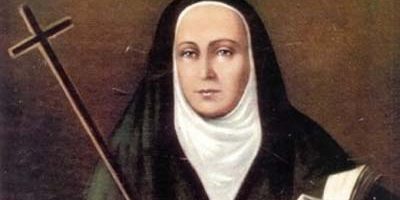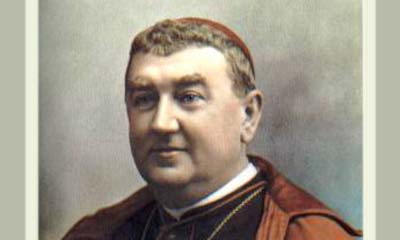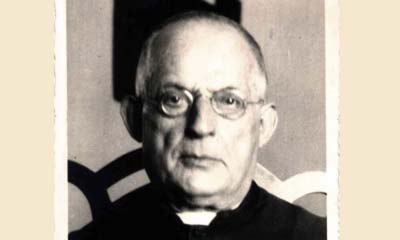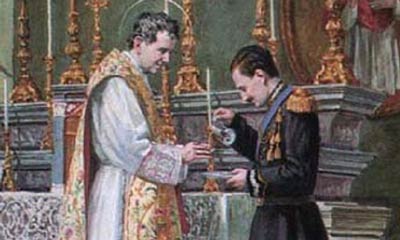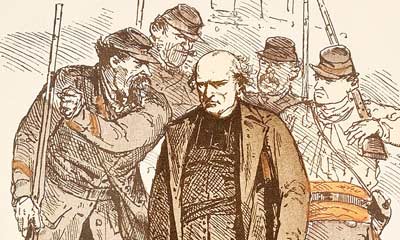May 15, 2024
Blessed María Antonia de Paz y Figueroa
Dear Friends,
“Nothing can be more pleasing to us than the recollection of the heavenly graces and the unutterable consolations which we have often experienced when occupied in the Spiritual Exercises, … of the light and the impulse that we drew from them, enabling us to know the divine will and to fulfill it… We may rightly conclude that a singular resource for the eternal salvation of souls is set in the Spiritual Exercises”, wrote Pope Pius XI in his encyclical on the Exercises of St Ignatius, Mens nostra (December 20, 1929). On February 11, 2024, a woman was canonized who, equally convinced of the exceptional worth of the Exercises, devoted her life to ensuring that their practice was not interrupted in Argentina in the 18th century following the suppression of the Society of Jesus.
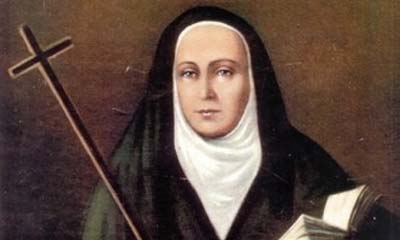 Born María Antonia de Paz y Figueroa in 1730 in Villa Silípica, in the northern province of Santiago del Estero, she became widely known in Argentina by the familiar name of Mamá Antula. Her parents were of the aristocracy. María Antonia and her three brothers received a solid education in which piety played a central role. She was a beautiful young girl, intelligent and dynamic. Her parents wanted her to find a “good match,” but she had decided to dedicate herself completely to God as a virgin and an apostle.
Born María Antonia de Paz y Figueroa in 1730 in Villa Silípica, in the northern province of Santiago del Estero, she became widely known in Argentina by the familiar name of Mamá Antula. Her parents were of the aristocracy. María Antonia and her three brothers received a solid education in which piety played a central role. She was a beautiful young girl, intelligent and dynamic. Her parents wanted her to find a “good match,” but she had decided to dedicate herself completely to God as a virgin and an apostle.
In 1585, the first Jesuit Fathers to arrive in the region had founded a school and deployed their most powerful means of apostolate, the Spiritual Exercises of their founder, St Ignatius of Loyola. They did not hesitate to go door-to-door to urge attendance at their retreats for men, which generally lasted seven to ten days. In Santiago del Estero, they were assisted by women who had consecrated themselves to God, the “Beatas”, who were full of fervor and eager to render all manner of services. These women prayed the three parts of the Rosary together each day, and led a very poor and austere life. They would keep house during retreats led by the Jesuit Fathers; in addition, they visited the sick and the needy, and helped with teaching children.
María Antonia took private vows when she was fifteen, donning a black dress similar to a Jesuit cassock as a public sign of her consecration, and assumed the name of María Antonia of Saint-Joseph. She was in contact with a community of Beatas in Santiago who were usually under the spiritual direction of Jesuits. She also corresponded with contemplative Carmelite and Dominican nuns in Córdoba and Buenos Aires, but was not attracted by their way of life. Her spirituality centered on the Holy Sacrifice of the Mass and a tender devotion to the Infant Jesus; she especially venerated the Blessed Virgin, St Joseph, St Ignatius, St Francis Xavier and St Stanislaus Kostka. She introduced Argentina to the devotion of St Cajetan of Thiene (1480-1547), founder of the Theatines for the renewal of the priestly ministry, education and mission; he is still frequently invoked as the patron saint of workers and job-seekers in present-day Argentina. María Antonia, full of smiles and caring for her fellow human beings, collaborated with the Jesuits in Santiago del Estero for over twenty years in developing the apostolate of the Spiritual Exercises.
The 18th century, however, saw growing hostility towards the authority of the Church: Pope Pius XI would later write that in those days, “the power of human reason was exalted beyond measure; all that exceeded the strength and measure of man, or was not contained within the domain of nature, was rejected and despised. Even the thrice-holy rights of God, be it in particular or socially, were counted for nothing” (Apostolic Letter Meditantibus Nobis, December 3, 1922). The Jesuits, who at the time played an important role as counsellors of princes and as educators of young people destined for high public office, were the victims of all kinds of aggression and persecution. The Protestant historian Sismondi (1773-1842) went so far as to write: “The chorus of accusations, and more often than not of slander, that we find directed against the Jesuits has something frightening about it. All the judiciary, a large part of the clergy, all the ‘philosophers’ and libertines had united to disparage the Jesuits” (History of the French, tome XXIX). The sovereigns of Portugal, France and Spain all turned against them. In 1767, King Charles III of Spain ordered the expulsion of the Jesuits from all his states, including the American colonies. Pope Clement XIII protested in vain. In Santiago del Estero, as in many other places, the expulsion was carried out brutally: soldiers took the Fathers away like criminals. In 1773, Pope Clement XIV, who had been circumvented in his turn, suppressed the Society of Jesus, which would not be reinstated until 1814 by Pope Pius VII.
Feeling Orphaned
When the Jesuits left, María Antonia felt as if she had been orphaned, and every time she came past their college, her heart broke afresh. She suffered greatly to see how the clergy seemed to have resigned itself to this injustice: anything remotely related to the Society of Jesus had become objectionable, and their very names were no longer mentioned. Against this backdrop of disapproval of the Spiritual Exercises, María Antonia, who was well aware of their worth for having practiced them for so many years and witnessed their abundant fruits, felt compelled to react. She set about defending the Fathers’ reputation in the face of hostile public opinion, and openly declared herself their disciple. In Santiago del Estero, at the express command of Our Lord, as she would later affirm, and with the permission of the ecclesiastical authorities, María Antonia prepared a large house where she organized retreats. She was especially skilled at finding good priests to lead the retreats following the method of St Ignatius, and she demonstrated the universality of the Exercises by having them preached by Franciscan and Dominican Fathers. Her discernment in this area, as in others, proved so acute and so sound that it could be attributed to God’s special assistance. The many fruits of these retreats testified to their being a spiritual therapy that brought healing to hundreds of lay people and priests, guiding them away from the broad path that leads to perdition (Mt 7:13) and transforming them into faithful disciples of Christ and apostles of his Gospel. Having been convinced that the gravest evil is sin (cf. Catechism of the Catholic Church, no. 1488), many were returning to obedience to God’s commandments, total faith in the Church’s teachings, a life of prayer and regular reception of the sacraments.
“Now it is recognized that among all the methods, … one has ever held the foremost place and adorned by the full and repeated approbation of the Holy See… [and] has borne abundant fruits of holiness during the space of well-nigh four hundred years; we mean the method introduced by St Ignatius of Loyola, whom we are pleased to call the chief and peculiar Master of Spiritual Exercises, whose ‘admirable book of Exercises’, a slender volume but so filled with divine wisdom, … ‘stood forth and conspicuous as a most wise and universal code of laws for the direction of souls in the way of salvation and perfection; an unexhausted fountain of most excellent and most solid piety; as a most keen stimulus, and a well instructed guide showing the way to secure the amendment of morals and attain the summit of the spiritual life,’” Pope Pius XI later wrote in his Encyclical Mens Nostra. The particular fruitfulness of the Exercises lies in its very schedule. Participants leave behind their everyday occupations and worries to come to a place of quiet, silence and recollection. They can devote several hours a day to solitary prayer, with the accompaniment of a priest. First, St Ignatius puts before their eyes their origin and ultimate end: the Principle and Foundation, of which Pope Leo XIII said: “In itself, the famous meditation of the Exercises on the ultimate end of man would suffice to bring about the complete recovery of society” (from an audience in 1894). Retreatants are then guided towards a profound purification of the soul, through consideration of their sins and the eternal consequences that these entail for those who do not turn to God’s infinite mercy. Next comes the contemplation of the life of the Savior, Jesus Christ, whom the retreatant strives to know ever better, so as to love him more ardently and follow him more faithfully. St Ignatius also offers various considerations on the spiritual life, including rules for the discernment of spirits.
The “Beata of the Exercises”
Driven by her ardent zeal to show souls the way to Heaven, María Antonia went beyond the boundaries of the city in search of retreatants. She scoured the countryside of northern Argentina on foot, enduring a thousand difficulties and contradictions. She was renowned for the exceptional quality of her prudence: whenever she must take a decision, she would seek the advice of wise people, and always asked the ecclesiastical authorities, be they bishops or parish priests, for all necessary permissions to announce the retreats on posters and at Sunday Masses. María Antonia also strove to advertise the retreats door to door and in the marketplaces. She relied on Providence to feed the retreatants, but was not above asking for donations; to this end, she acquired a donkey to pull a cart. She became a well-known figure throughout the region, with her walking staff shaped like a cross. Indeed, there was never a shortage of food, no matter how many retreatants there were. María Antonia herself admired God’s goodness: whatever was needed arrived in good time, and the retreatants came flocking. For many, she became an example of humble, spontaneous simplicity. She came to be known as the “Beata of the Exercises”.
“Moreover, from this perfection of life, which is manifestly obtained from the Spiritual Exercises, besides that inward peace of the soul, there springs forth spontaneously another most choice fruit, which redounds to the great advantage of the social life: namely that desire of gaining souls to Christ which is known as the Apostolic Spirit. For it is the genuine effect of charity that the just soul, in whom God dwells by grace, burns in a wondrous way to call others to share in the knowledge and love of that Infinite Good, which she has attained and possesses” (Pius XI, Mens nostra).
The Lord blessed María Antonia with the gift of miracles. One day when the house was full of retreatants, there was no bread. María Antonia told her niece, who was working with her and who had told her of the situation, to go and check at the door: there the girl discovered baskets of delicious white bread, the origin of which no one could explain. On another occasion, the small barrel in which the wine was kept was empty. To prevent the wood from drying out, it had been filled with water. Those who went to draw from it found it full of a delicious wine, which would even be used by the priests to celebrate Mass.
The Future Restoration
Maria Antonia travelled to Córdoba, the regional metropolis. There she met with strong opposition: people were scandalized to see a poorly dressed woman who had received no advanced education promoting the message of the Gospel. But her humility, patience and gentleness allowed her to overcome all obstacles. She rented a house and found priests to preach the Exercises. At the beginning of 1778, in three and a half months, some 3,000 people, both men and women, had already attended the retreats. Many conversions took place. Such success showed her that there was much good to be done in the big cities. In Córdoba, the Lord foretold to her the future restoration of the Society of Jesus: amidst the ruins resulting from the expulsion of the Jesuits, she saw their churches as if plunged into darkness; then she saw a small point of light and an angel of God descended from Heaven, lighting a wick that illuminated all the sanctuaries where liturgical life would return to its fullness and beauty. This vision sustained her through dark and difficult hours. Fortified by this certainty, she asked for a Mass to be celebrated on the 19th of each month in honor of St Joseph, patron saint of her work, to obtain the grace of this restoration.
After having organized seventy retreats in Córdoba and having planned everything to ensure that this work would continue, María Antonia returned to Santiago del Estero. Eleven years had passed since the opening of the first Retreat House for the Exercises in that city. She had covered some two thousand miles (3,000 km) on foot. Bishops and a large number of priests had been transformed by their encounters with her, as had provincial governors and a great many people from all walks of life. She wrote to an exiled Jesuit, Father Juárez: “I have a great desire to inherit the spirit of he who composed the Exercises… with the hope of reforming the spirit of the whole world, starting with Christendom.”
With cross in hand and the cry of “God wills it”, María Antonia then set off for Buenos Aires, where the Lord was summoning her. She undertook the journey of nearly six hundred miles (1,000 km) with a few fellow Beatas, arriving in the capital in 1779. The arrival of this small group of women attracted a lot of attention. When a group of young men threw stones at them, they took refuge in a small sanctuary, the church of La Piedad (“Our Lady of Pity”, which was later to become a large basilica). This shrine always remained dear to the heart of María Antonia, who asked to be buried there. The Beatas were then welcomed into a family from Santiago del Estero. María Antonia immediately began to talk about conversion and penance, which was frowned upon in the city. She herself practiced intense prayer and penance: she took to walking barefoot and wearing a cilice. Soon she presented herself at the Episcopal palace, but was not admitted to the bishop’s audience. She had to return regularly for several months before being able to meet him, against a background still marked by the expulsion of the Jesuits. “Patience is good,” she was fond of saying, “but perseverance is even better.” Convinced at last, the bishop granted her all the necessary permissions, upon which María Antonia organized the first retreats. In 1781, twenty-nine retreats were held, some of them with two hundred participants. Highly satisfied with the results, the bishop volunteered to give some of the lectures himself. The rector of the cathedral of Buenos Aires, having taken part in the Exercises as their chaplain, gave up his post and possessions to devote himself to accompanying María Antonia in her ministry. Thanks to Providence and collections, the retreats were offered free of charge. Food for the retreatants arrived in such abundance that there was enough for distributions to the poor.
Thoughtful Care
In 1791-1793, María Antonia spent three years in Montevideo, Uruguay, on the other side of the River Plate, where she set up a house for the Exercises. After her return to Buenos Aires, a substantial donation of land enabled her to found the “Holy House of the Exercises” in 1797, for retreats of up to a hundred people, with lodgings for the Beatas. There, she welcomed the retreatants, making sure they had everything they needed, finding ways to encourage them with a smile or a kind word, and highlighting the more festive moments. There were books at the disposal of those retreatants with a higher level of education. Some of the exercises were illustrated with devotional images, representations and short plays. The chapel and corridors featured a wealth of paintings and statues. The house was home to an image of Jesus of Nazareth which had the reputation of having worked miracles.
Pope Pius XI said of the retreatant practicing the Exercises: “Cultured by heavenly teaching, he may form a just estimate, and understand the value of human life devoted to the service of God alone; he may abhor the turpitude of sin; he may conceive the holy fear of God; he may clearly see unveiled the vanity of earthly things; and, stirred up by the precepts and the example of Him who is the way, the truth and the life, he may put off the old man, may deny himself, and with humility, obedience, and voluntary chastisement of self, may put on Christ and strive to attain to the perfect man, and to that absolute measure of the age of the fulness of Christ whereof the Apostle speaks; nay, more, may endeavor, with all his soul, to be able to say himself, with the same Apostle: It is no longer I who live, but Christ who lives in me” (Mens Nostra).
When she had a little spare time, María Antonia visited the poor, providing them with physical and spiritual assistance. In her desire for the conversion of people estranged from God, she welcomed women who had repented after a dissolute life with great charity. She also looked after abandoned children. Her exemplary humility enabled her to resolve family and even ecclesiastical disputes, comfort prisoners and instill confidence and serenity in one and all.
The “Daughters of the Divine Savior”
Maria Antonia surrounded herself with a number of women who, following her example, dedicated themselves totally to God and to the work of the retreats. They also taught catechism in the parishes. The beguinage founded for them in 1795 gave birth to the “Society of the Daughters of the Divine Savior”, which would continue the work of the retreats, devote itself to religious education at all levels, organize rural missions and offer aid to those most in need.
Now in her sixties, María Antonia, who was still burning with zeal for souls, wanted to offer the retreats to an even larger number of people. She was being begged to return to Tucumán and Santiago, but she refused, as she now felt she had to concentrate her efforts on Buenos Aires. Her letters to the Jesuits in exile were often copied, translated into Italian, French and Latin, and distributed throughout Europe. Some even reached Madame Louise of France, the daughter of King Louis XV, who had become prioress of the Carmelite convent at Saint-Denis under the name of Mother Thérèse of Saint Augustine. A short note on María Antonia, published in Rome as early as 1791 under the title: The banner of the woman of worth (cf. Pr 31, 10), reveals the high esteem in which she was held even in Europe.
María Antonia persevered in her austere life, with only bread and a few vegetables for nourishment. She endured great inner sufferings. With her health deteriorating, she wrote her spiritual will, in which she asked that her funeral be held without any external pomp, but with fervent prayers. Three days before she died, she made herself be carried to the stone bench in front of the front door of the house, and from there she told passers-by that they must convert and do penance for their sins, announcing great punishments for the town, especially because of the immodesty of their dress. On March 6, 1799, she was taken ill with a high fever, and died the following day at the age of 69. Her body lies in the Basilica of Our Lady of Mercy (or of Pity) in Buenos Aires, where it is venerated by large numbers of pilgrims.
Blessed María Antonia’s interior life was nourished by great faith in God and His Providence. She was an unknown woman, lacking both power and authority, yet she devoted all her energies to calling the faithful to conversion through the practice of the Spiritual Exercises of St Ignatius. This tireless missionary, who was a pioneer in the formation of both lay people and priests, led a large part of South America to Christ. An estimated 80,000 people benefited from the retreats that she organized.
Offering the Spiritual Exercises “means to invite to an experience of God, of His love and of His beauty. He who lives the Exercises in a genuine way experiences attraction, is fascinated by God, and returns renewed, transfigured to ordinary life, to the ministry, to daily relations, bearing within him the fragrance of Christ” (Pope Francis, March 3, 2014, Address to participants in the Assembly of the Italian Federation of Spiritual Exercises). Let us ask Blessed María Antonia to obtain for many the grace of doing the Exercises and of deriving great spiritual benefit from them for the salvation of their souls, of many other souls, and for the good of the Church and the world.


